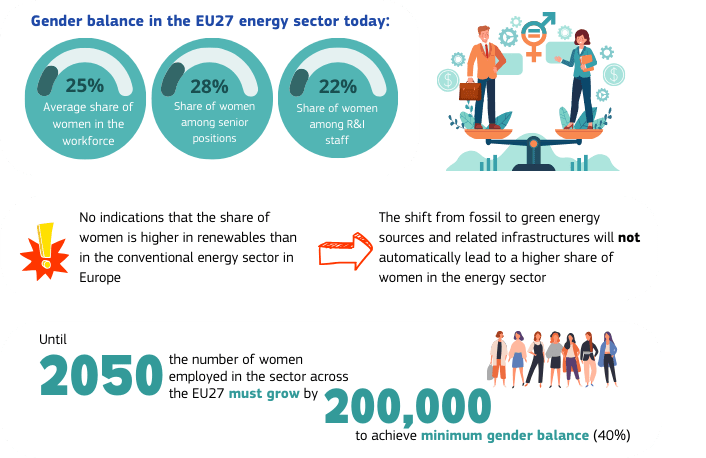Together with our partners, we conducted a study for the European Commission to assess the gender balance in the energy sector and specifically the energy transition and identify strategies for inclusivity. Understanding and addressing gender balance in the European energy sector is crucial for the success of the energy transition, a key component of the European Green Deal, as about 1.6 million Europeans work in the energy field. We notice and underscore the dual imperative of integrating more women into research and innovation (R&I) roles and achieving gender parity across the energy sector to drive forward a sustainable, inclusive, and equitable energy transition.
The energy sector, historically male-dominated, mirrors broader societal challenges of gender imbalance, particularly in science, technology, engineering, and mathematics (STEM) fields. Yet, this imbalance is not just a matter of equity but also a strategic disadvantage. A more gender-balanced workforce brings diverse perspectives, fostering innovation and resilience in tackling the complex challenges of transitioning to sustainable energy.
The State of Gender Balance
Women constitute only about 25% of the workforce in EU energy sector companies, with even lower representation in senior positions and R&I roles. This stark imbalance underscores a significant underutilization of potential talent and perspectives essential for driving innovation in the sector. In comparison, the share of women in the construction industry is 11%, transport 23%, ICT and manufacturing 30/31%, public administration 49%, finance and insurance industry 53%, education 73% and health 70%.
Based on our analysis of differences by each energy subsector, we must dispel the myth that the shift towards renewable energies automatically correlates with increased gender diversity. Instead, it highlights that without deliberate efforts, renewable energy sectors might replicate the gender imbalances of traditional energy industries. This realization calls for targeted interventions to ensure that the green transition also advances gender equity.
Strategic Recommendations: Pathways to Inclusion
To address these disparities, we identified recommendations for policymakers, industry leaders, and educational institutions:
- Promoting STEM Education Among Women: Enhanced outreach and support for girls and women in STEM education can gradually increase the pipeline of female talent in the energy sector. This includes addressing stereotypes, providing mentorship, and showcasing female role models in energy careers.
- Flexible Working Conditions: The implementation of flexible work arrangements can significantly enhance the sector’s appeal to women, facilitating work-life balance and enabling more women to pursue and sustain careers in energy.
- Inclusive Corporate Cultures: Cultivating an organizational culture that values diversity and inclusivity is critical. This involves not only implementing policies that prevent discrimination and support gender equality but also promoting a workplace environment where diverse voices are heard and valued.
- Targeted Recruitment and Retention Strategies: Companies must adopt gender-sensitive recruitment practices, ensuring that job advertisements, selection processes, and career development opportunities are designed to attract and retain female talent.
- Leadership and Accountability: Strong commitment from top management is crucial in driving gender balance initiatives. Setting clear targets, monitoring progress, and holding leaders accountable for achieving gender diversity goals can significantly accelerate progress.
Call to Action
The energy transition offers a unique opportunity to redefine the sector not only in terms of sustainability but also inclusivity. By embracing gender balance as a strategic imperative, the energy sector can unlock a wealth of innovation, resilience, and social equity, paving the way for a more sustainable and equitable future. The time for action is now, and it requires the concerted efforts of all stakeholders to make gender equity in energy a reality.
About the study
Our study was conducted together with our partners ÖGUT, Portia, DIW Econ, Fraunhofer IAO CeRRI and gddc, for the European Commission’s Climate, Infrastructure and Environment Executive Agency (CINEA), to analyse the size and nature of this challenge and to identify success factors for effective interventions across 35 countries – the EU27 plus 4 other European countries as well as Australia, Canada, Turkey, and the US. In our analysis, we reviewed the impact of gender imbalances on the energy sector, specifically its effect on the capability of the EU to design and lead the energy transition in ways which are not only effective, but also socially and economically sustainable.
Resources:
- Download the Final Report
- Download the Executive Summary
- Download an infographic with the main findings
- Download the collected Country Briefs for EU27 and 8 further countries
- The survey instruments are here: Company survey questionnaire, Employee survey questionnaire, Student survey questionnaire.
- The raw data and metadata of the surveys can be accessed through ZENODO: Company survey data, Employee survey data, Student survey data.
